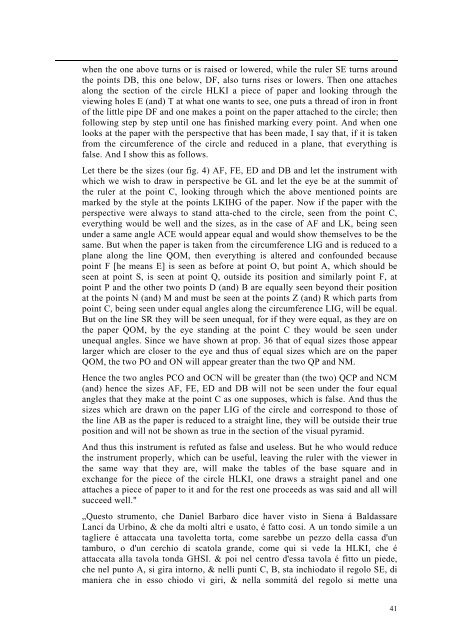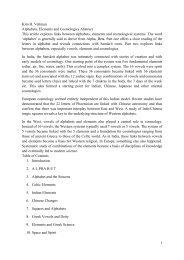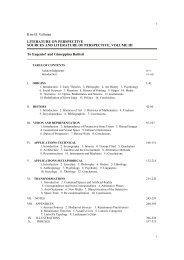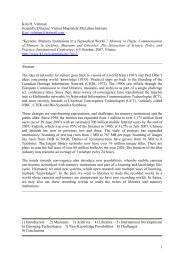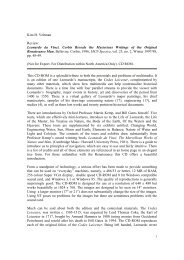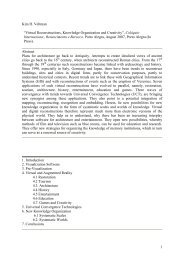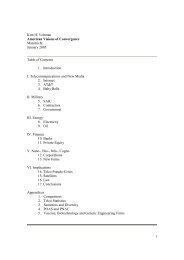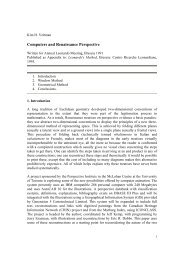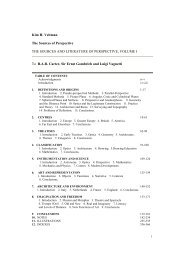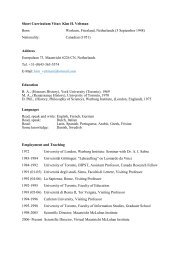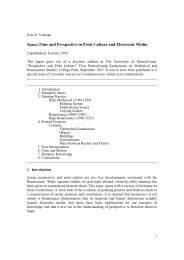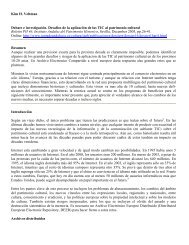1986 Perspective, Anamorphosis And Vision
1986 Perspective, Anamorphosis And Vision
1986 Perspective, Anamorphosis And Vision
Create successful ePaper yourself
Turn your PDF publications into a flip-book with our unique Google optimized e-Paper software.
when the one above turns or is raised or lowered, while the ruler SE turns around<br />
the points DB, this one below, DF, also turns rises or lowers. Then one attaches<br />
along the section of the circle HLKI a piece of paper and looking through the<br />
viewing holes E (and) T at what one wants to see, one puts a thread of iron in front<br />
of the little pipe DF and one makes a point on the paper attached to the circle; then<br />
following step by step until one has finished marking every point. <strong>And</strong> when one<br />
looks at the paper with the perspective that has been made, I say that, if it is taken<br />
from the circumference of the circle and reduced in a plane, that everything is<br />
false. <strong>And</strong> I show this as follows.<br />
Let there be the sizes (our fig. 4) AF, FE, ED and DB and let the instrument with<br />
which we wish to draw in perspective be GL and let the eye be at the summit of<br />
the ruler at the point C, looking through which the above mentioned points are<br />
marked by the style at the points LKIHG of the paper. Now if the paper with the<br />
perspective were always to stand atta-ched to the circle, seen from the point C,<br />
everything would be well and the sizes, as in the case of AF and LK, being seen<br />
under a same angle ACE would appear equal and would show themselves to be the<br />
same. But when the paper is taken from the circumference LIG and is reduced to a<br />
plane along the line QOM, then everything is altered and confounded because<br />
point F [he means E] is seen as before at point O, but point A, which should be<br />
seen at point S, is seen at point Q, outside its position and similarly point F, at<br />
point P and the other two points D (and) B are equally seen beyond their position<br />
at the points N (and) M and must be seen at the points Z (and) R which parts from<br />
point C, being seen under equal angles along the circumference LIG, will be equal.<br />
But on the line SR they will be seen unequal, for if they were equal, as they are on<br />
the paper QOM, by the eye standing at the point C they would be seen under<br />
unequal angles. Since we have shown at prop. 36 that of equal sizes those appear<br />
larger which are closer to the eye and thus of equal sizes which are on the paper<br />
QOM, the two PO and ON will appear greater than the two QP and NM.<br />
Hence the two angles PCO and OCN will be greater than (the two) QCP and NCM<br />
(and) hence the sizes AF, FE, ED and DB will not be seen under the four equal<br />
angles that they make at the point C as one supposes, which is false. <strong>And</strong> thus the<br />
sizes which are drawn on the paper LIG of the circle and correspond to those of<br />
the line AB as the paper is reduced to a straight line, they will be outside their true<br />
position and will not be shown as true in the section of the visual pyramid.<br />
<strong>And</strong> thus this instrument is refuted as false and useless. But he who would reduce<br />
the instrument properly, which can be useful, leaving the ruler with the viewer in<br />
the same way that they are, will make the tables of the base square and in<br />
exchange for the piece of the circle HLKI, one draws a straight panel and one<br />
attaches a piece of paper to it and for the rest one proceeds as was said and all will<br />
succeed well."<br />
„Questo strumento, che Daniel Barbaro dice haver visto in Siena á Baldassare<br />
Lanci da Urbino, & che da molti altri e usato, é fatto cosi. A un tondo simile a un<br />
tagliere é attaccata una tavoletta torta, come sarebbe un pezzo della cassa d'un<br />
tamburo, o d'un cerchio di scatola grande, come qui si vede la HLKI, che é<br />
attaccata alla tavola tonda GHSI. & poi nel centro d'essa tavola é fitto un piede,<br />
che nel punto A, si gira intorno, & nelli punti C, B, sta inchiodato il regolo SE, di<br />
maniera che in esso chiodo vi giri, & nella sommitá del regolo si mette una<br />
41


